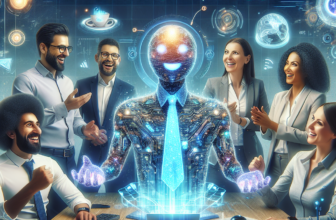Bridging Generations: Navigating Team Dynamics in Multigenerational Workforces
Introduction
In today's workforce, the presence of multiple generations can be both a challenge and an opportunity for businesses.
Bridging generations involves understanding the unique traits of each demographic, fostering effective communication, and leveraging diverse skills for optimal productivity. This article will delve into the intricacies of multigenerational workforces, examining dynamics, strategies, and real-world applications.
Section 1: Understanding Multigenerational Workforces
The Generations at Work
Today's workplace comprises four main generations:
- Baby Boomers (born 1946-1964)
- Generation X (born 1965-1980)
- Millennials (born 1981-1996)
- Generation Z (born 1997-2012)
Each group brings distinct traits shaped by their experiences, which significantly influence team dynamics and productivity.
Characteristics and Contributions
Understanding the distinct characteristics of these generations is crucial for effective management. Each generation brings a unique set of skills, perspectives, and values to the table:
- Baby Boomers: Value loyalty, teamwork, and tend to be hard-working.
- Generation X: Known for independence, practicality, and technological adaptability.
- Millennials: Thrive on collaboration, social responsibility, and flexibility in the workplace.
- Generation Z: Digital natives, value quick communication, and expect innovative work environments.
Section 2: The Importance of Diversity
Benefits of Diverse Teams
A multigenerational workforce brings a wealth of diversity that fosters creativity and innovation. Companies benefit from:
- Enhanced Problem Solving: Diverse teams are more likely to offer different perspectives and solutions.
- Increased Market Reach: Understanding varied demographics allows businesses to cater to a broader audience.
- Knowledge Transfer: Experienced employees can mentor younger workers, while fresh recruits can introduce new ideas.
Challenges of Diversity
Despite its advantages, a multigenerational workforce also presents unique challenges:
- Communication Barriers: Different preferences can lead to misunderstandings and conflict.
- Resistance to Change: Older employees may be less adaptable to new technologies compared to younger generations.
- Generational Stereotypes: Biases can hinder collaboration and trust among team members.
Section 3: Communication Styles Across Generations
Preferred Communication Methods
Different generations have distinct communication styles, which can impact teamwork:
- Baby Boomers: Prefer face-to-face meetings and more formal communication.
- Generation X: Enjoy a blend of direct and written communication, valuing efficiency.
- Millennials: Favor instant messaging and collaboration tools, seeking speed over formality.
- Generation Z: Prefer multimedia communication, including video and social platforms.
Impact of Technology
Technology significantly influences communication styles. For instance:
- Millennials and Generation Z thrive on mobile communication, pushing companies to adopt the latest tools.
- Baby Boomers may feel overwhelmed by rapid technological changes, emphasizing the need for tech training.
Bridging these communication gaps is crucial for effective team dynamics in multigenerational workforces.
Section 4: Leadership Strategies for Multigenerational Teams
Fostering Inclusion
Effective leadership involves creating an inclusive environment where all generations feel valued. Strategies to promote inclusion include:
- Open Communication: Encourage feedback from all team members, regardless of age.
- Inclusive Policies: Develop policies that cater to the needs of all generations, such as flexible work arrangements.
- Cultural Awareness: Organizations should provide training to raise awareness about generational differences.
Conflict Resolution Techniques
Conflicts can arise in multigenerational teams, necessitating specific resolution techniques:
- Active Listening: Encourage team members to listen actively to understand different perspectives.
- Mediation: Implement mediation processes to address grievances sensitively.
Bridging disparate viewpoints will foster cohesion and teamwork.
Section 5: Building Synergy Among Generations
Collaborative Projects
Collaborative projects are an excellent way to build synergy:
- Create mixed-age teams for projects to encourage knowledge sharing.
- Develop intergenerational task forces to tackle specific challenges.
This format promotes interdependence and camaraderie among employees of all ages.
Mentorship Programs
Mentorship can play a crucial role in bridging generations:
- Pair younger employees with seasoned veterans to facilitate knowledge exchange.
- Develop reverse mentorship programs, where younger employees can mentor older colleagues in new technologies.
Section 6: Real-life Examples and Case Studies
Case Study: Successful Multigenerational Teams
A notable example comes from Company XYZ, which implemented a mentorship program that paired Baby Boomers with Millennial employees. This approach resulted in enhanced communication and collaboration, leading to a significant increase in project success rates.
Lessons Learned
The lessons learned from Company XYZ emphasize:
- The importance of open communication in mitigating generational conflicts.
- Utilizing diverse perspectives to innovate effectively.
Q&A Section
Q: What are the key challenges faced in multigenerational workforces?
A: Challenges include communication barriers, differences in work styles, and potential generational biases.
Q: How can organizations create a harmonious work environment?
A: By fostering inclusion, implementing mentorship programs, and encouraging open communication among all generations.
Q: What strategies can improve collaboration?
A: Utilize collaborative technologies, create mixed-age project teams, and promote intergenerational networking.
Q: Why is mentoring important in a multigenerational workforce?
A: Mentoring facilitates knowledge transfer between generations and helps younger employees grow while providing older workers with fresh insights.
Q: How can organizations address stereotypes in the workplace?
A: Train employees to recognize and challenge stereotypes, fostering a culture of respect and understanding.
FAQ Section
1. What is a multigenerational workforce?
A multigenerational workforce includes employees from several generations working together, showcasing diverse skills and perspectives.
2. How can I improve communication in a multigenerational team?
By understanding generational communication styles and utilizing a mix of communication tools that cater to all demographics.
3. What resources are available for managing multigenerational teams?
Various resources, including training programs and articles about bridging generations, can help managers effectively lead diverse teams.
4. How can leadership strategies foster team cohesion?
Effective leadership strategies include encouraging participation, recognizing individual contributions, and addressing conflicts constructively.
5. Why is it important to understand generational differences in the workplace?
Understanding these differences can enhance teamwork, improve communication, and ultimately lead to increased productivity and employee satisfaction.
Resources
| Source | Description | Link |
|---|---|---|
| Forbes | Understanding multigenerational teams and how to manage them. | Read More |
| SHRM | Article on the benefits of a diverse workforce. | Read More |
| Harvard Business Review | Strategies for successful generational collaboration. | Read More |
| McKinsey | Insights on diversity and innovation. | Read More |
| LinkedIn Learning | Course: Leading Multigenerational Teams. | Read More |
Conclusion
Successfully navigating team dynamics in multigenerational workforces requires understanding, respect, and effective management strategies. By embracing diversity, fostering open communication, and implementing structured mentorship programs, organizations can bridge the gap between generations, ultimately leading to enhanced productivity, innovation, and a well-rounded workplace culture.
Disclaimer
This article was created with assistance from artificial intelligence (AI) to enhance research and drafting efficiency. All content has been reviewed and refined by human contributors.










